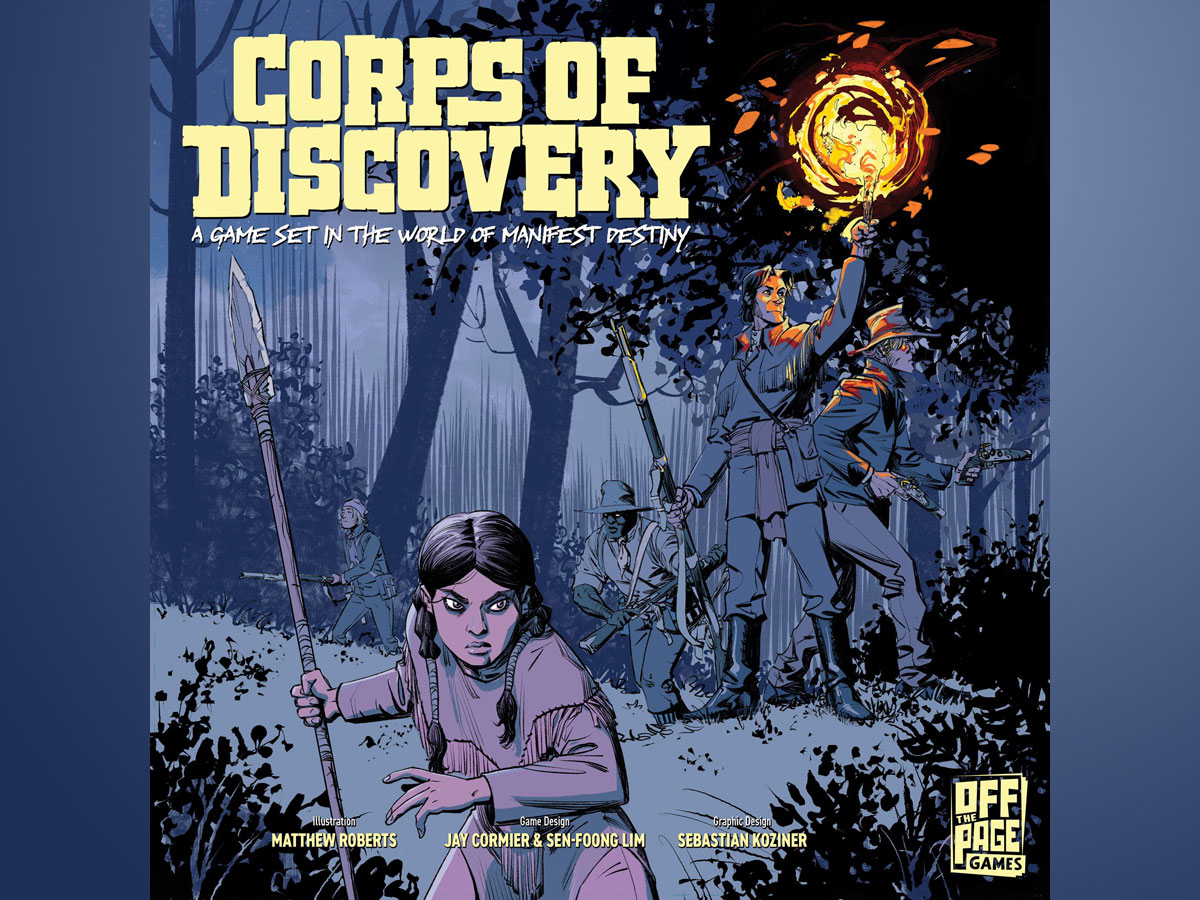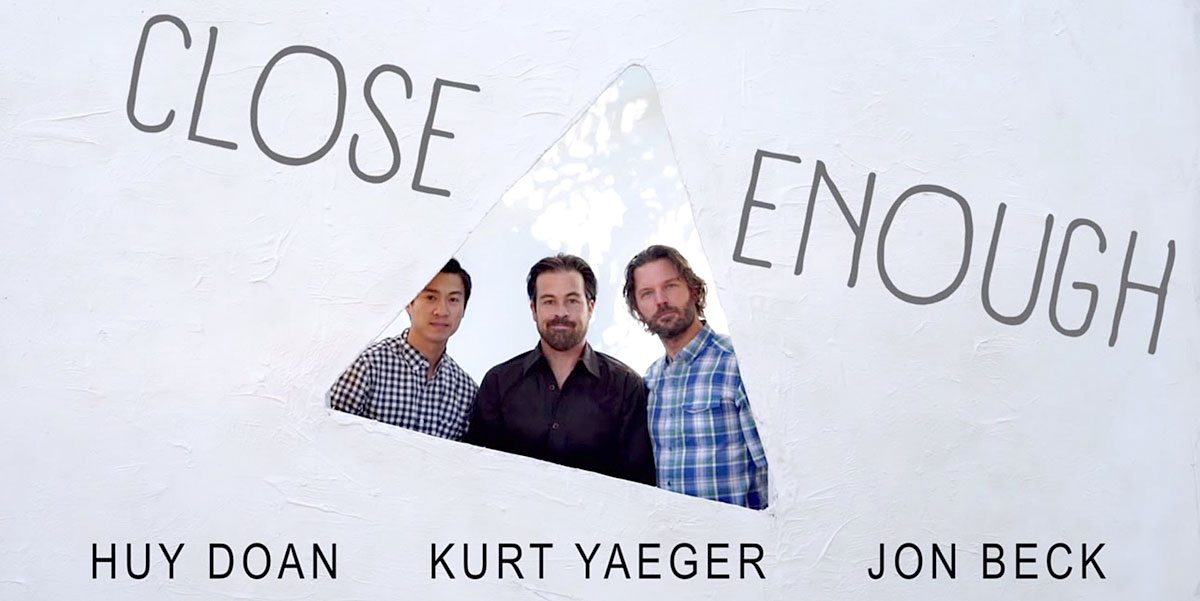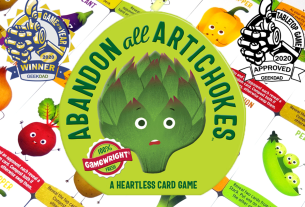You probably learned in school that Lewis and Clark were commissioned by the President to explore the Louisiana Purchase. What you didn’t know is that their secret mission was to hunt down monsters!
What Is Corps of Discovery?
Corps of Discovery is a cooperative deduction game for 1 to 4 players, ages 14 and up, and takes about 45 to 75 minutes to play. It’s currently seeking funding on Kickstarter, with a pledge level of $53CAD (about $39USD) for a copy of the retail edition of the game. There are additional tiers for the deluxe edition (with wooden components), and the four expansions may be purchased as add-ons, or included in the “Ultimate Edition” pledge tier. While the comic books the game is based on are intended for adult readers, the game itself does not seem to get quite as explicit (though I have only seen the first two chapters); since it is a cooperative game, you can judge whether your kids would enjoy working through the logic, given the theme of monsters and giant carnivorous plants and the like.
Corps of Discovery was designed by Jay Cormier and Sen-Foong Lim and published by Off the Page Games, with illustrations by Matthew Roberts. It is based on the comic book series Manifest Destiny, written by Chris Dingess and illustrated by Matthew Roberts—more on that later!
New to Kickstarter? Check out our crowdfunding primer.

Corps of Discovery Components
Note: My review is based on a prototype copy, so it is subject to change and may not reflect final component quality.
Here’s what comes in the base game:
- Map board
- Map Hider sheet
- 2 Map folders (Fauna and Flora, each with 8 maps)
- 49 Path tokens
- Supply board
- 2 Reference boards
- 11 Destiny cards
- 4 Kill Minotaur cards
- 5 Character cards
- 8 Gear cards
- 24 Challenge cards
- 6 Threat cards
- 7 Search cards
- 36 Resource tokens
- 14 Water tokens
- 3 Fort tokens
- 3 Fire tokens
- Greek Fire token
- 4 Sample tokens
- 8 Flora Terrain tokens
- 4 Minotaur tokens
- Shelter token
- 3 Teepee tokens
- 5 Crew tokens
Kickstarter backers will receive 10 additional maps. One particular note is that the maps included in the prototype (and the maps shown in the rulebook) are not the same as what will be in the finished game, so that you will not get spoilers for the maps from the review. Also, the map board and path tokens in the prototype are a boring solid green, but it looks like the finished game will have a little more artwork in the background and on the backs of the tokens to make them a little more visually interesting.
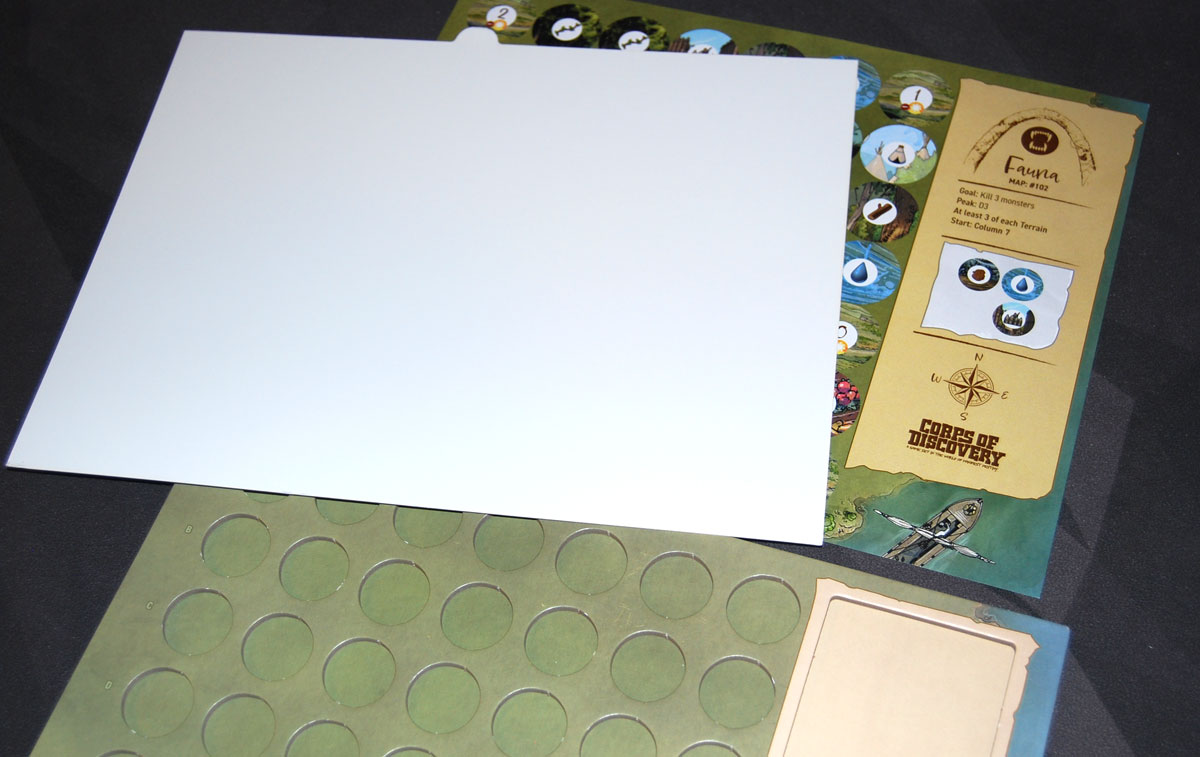
The map board is kind of a sandwich: the top layer has a grid of 49 holes, plus a larger rectangular window. Each of the maps has a matching grid of resources/locations, and you use the map hider sheet to cover the map, and slide it into the board. Then you place all the path tokens over the holes, and slide the hider sheet out, revealing just the reference section in the window but obscuring the map itself. The path tokens are also double-layered, with a smaller circle part that fits into the map board and a larger part that rests on top—that ensures that the map underneath is entirely covered up, but that the tokens won’t slide around. The folders themselves are designed with a small window so that you can see the map number without looking at the map itself. It’s slightly fiddly but is crucial to the way the game works.
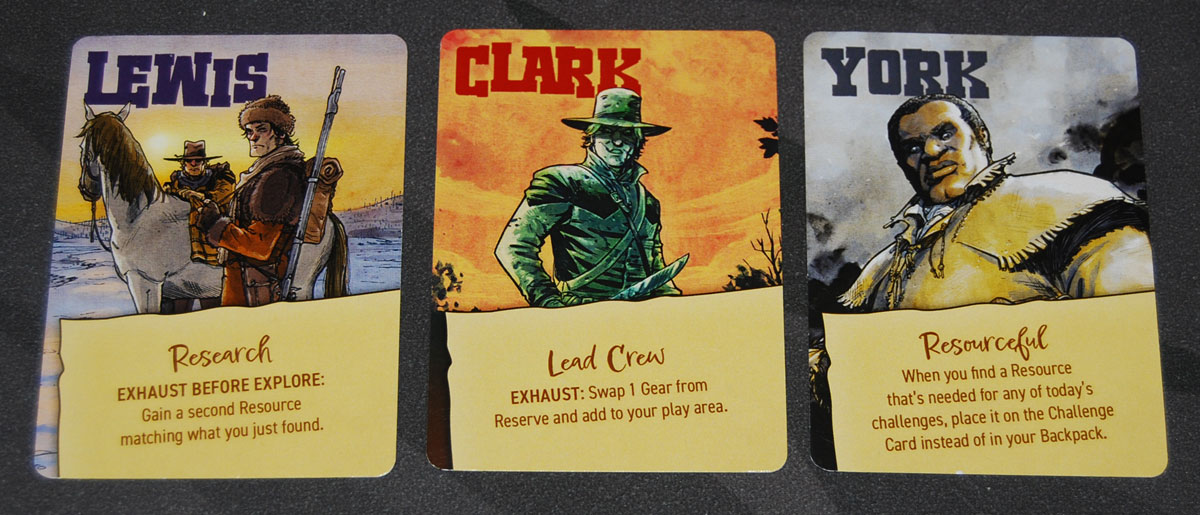
The rest of the components are fairly standard fare—cardboard tokens and cards in two different sizes. They feature artwork by Matthew Roberts, presumably many pulled from the comic books but I imagine at least some of it was newly illustrated for the game as well.
How to Play Corps of Discovery
You can download a draft of the rulebook here. It’s also available to try for free on Tabletop Simulator.
The Goal
Each chapter has its own specific goal, but generally you are trying to explore and complete a mission before your team starves or runs out of water. In Fauna, your mission is to kill 3 monsters; in Flora, you need to make your way to the Giant Plant and burn it with Greek fire.

Setup
Select a map to play, slide it into the board, and cover it with the path tokens using the map hider sheet. The map may indicate some starting things to mark—for instance, if it gives coordinates for the peak, then you place a rock resource on the map at that location. It will also indicate where you will begin exploring.
Many of the components have icons indicating which chapter they’re for—you’ll need to find the cards that match your chapter and set aside the rest.

By the supply board, shuffle the deck of challenges. Place the “Approaching the Arch” card in the first slot, and then draw two more challenge cards to place face-up in the next two slots. Put 8 water in your supply at the bottom. Shuffle the chapter-specific threats together with the Injured and Chased cards to make the threat deck. Shuffle the destiny deck and turn two of them face-up above the reference board for your chapter.
Each player chooses a character to play and picks gear—the number of gear cards you get depends on the player count. Whoever most recently read a comic goes first.
Gameplay
On your turn, you always explore a path, and then you can do free actions, and then you resolve the challenge board if needed.

To explore a path, you just remove one of the path tokens. You have to explore adjacent to already-revealed spaces (since you’re making your path across this unknown terrain), but you cannot go through mountains, which are outlined in red as a reminder. For most spaces, if it shows a resource, you gain that resource and add it to backpack on the supply board.

Some spaces have other effects, explained on the reference board: in the first chapter, teepees will let you trade resources, and forts will give you a “Kill Minotaur” card. There are hill spaces that show a number—this usually gives you some information about where something is hidden, like the number of forts that are in this hill’s row or column. Other spots on the board are monster lairs (showing a skull). When you encounter one of these, you must draw a threat card—it might add a monster to the board, or you could end up injured (having fewer challenge card spaces) or chased (cannot use destiny cards).

Free actions include things like using your character’s special ability, a gear card, a destiny card, or a “Kill Minotaur” card. You can also build a shelter if you’ve found a suitable location or build fires. Aside from some chapter-specific fire effects, you can also spend 2 fire to backtrack: instead of activating the terrain you just explored, cover it back up and rewind to the start of your turn and explore somewhere else instead.

At the end of your turn, put the path token in a stack on the leftmost challenge card. Each challenge card has a time limit: if the number of path tokens on the card meets the limit, then you must resolve the challenge. Each card has a number of resources you must spend or conditions that must be met. If you succeed, you get the results of the “Pass” side; otherwise you take the consequences shown on the “Fail” side, which often entails losing resources.
After resolving a challenge card, you also check for fatigue: if you have resources filling up to the red spaces in your backpack and you don’t have a shelter, then you are fatigued—you’ll have to either discard some resources or lose a water.

The day ends after all 3 challenge cards have been resolved, and then you follow the instructions on the supply board. First, you must feed your troops by spending a food. Then, during the night phase you will add a threat card if there aren’t any monsters currently in play, refresh all character and gear cards, and draw three new challenge cards for the next day.
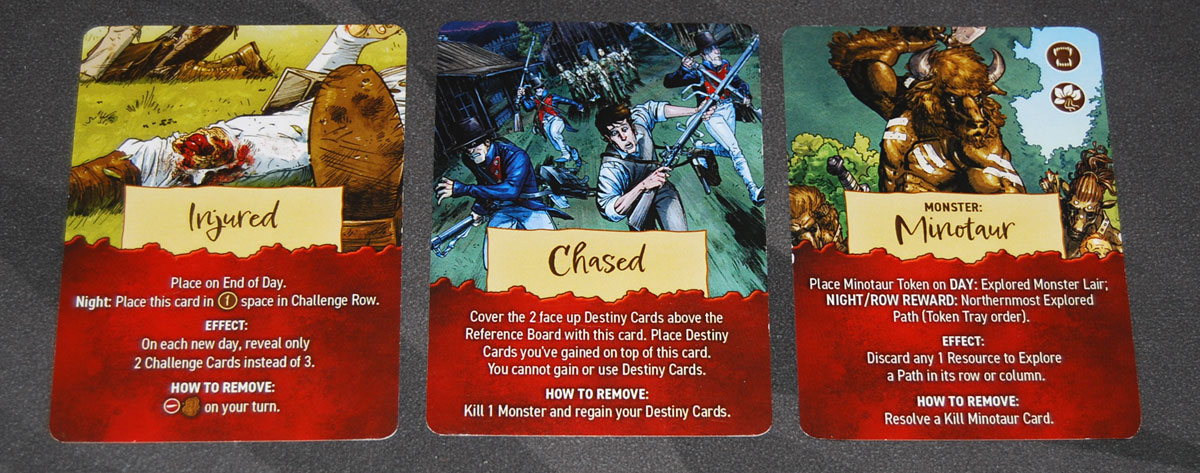
Game End
The game ends when you succeed in your mission—you win! Otherwise, if you ever need to spend water and cannot, then you die of thirst and lose. Also, at the end of each day, you must consume food—if you don’t have food by the end of a day, then you starve and lose.
If you win, you add up all of the time limits on challenge cards still remaining on the supply board and the deck—that’s your score! Compare it to the table in the rulebook to check your rank, from Greenhorn Scout to Master Explorer.
Why You Should Play Corps of Discovery
Before I get into the game itself, it’s worth talking a little bit about the comic it’s based on. I hadn’t heard of Manifest Destiny before, but I knew there had been some discussion about the title when the board game was first announced, eventually leading to the change to Corps of Discovery for the game. You can read a little more about that background here from Sen-Foong Lim, one of the designers.

The comic is an alternate history of Lewis and Clark, one in which North America is populated not only by Indigenous peoples, but also by strange monsters. The first issue is available to read for free, so I decided to give it a try after having played the game a couple of times. Right from the start, you find out that this isn’t going to be a typical portrayal of Lewis and Clark: Lewis spots a bird he’d like to get a better look at, so Clark obliges by shooting it out of the sky. You soon find out that the Corps includes a contingent of “volunteers” in addition to the enlisted men—mercenaries and convicts who have had their sentences commuted—and they’re primarily there as monster fodder. Lim explains that the books had 48 issues to tell the story and to reframe and critique the concept of “manifest destiny” in a way that is much harder to do in a board game, so they made the choice to give it a different title that still sets it in the same world but doesn’t feel like it’s promoting or condoning that doctrine.
The game apparently follows the general plot of the books: the first chapter, Fauna, has you face off against minotaurs, which are encountered in the first issue of the comic, and the first challenge every time you play is “Approach the Arch,” a reference to a mysterious plant-covered arch the Corps discovers at the opening of the story. However, there isn’t a lot of text telling the story itself—it’s more like a brief summary that just gives you enough info to set the scene for the game.
Back when I was a kid, I played a computer game called Hunt the Wumpus. You wandered around in a cave (a grid of circles connected by paths), and each time you entered a room you got some information: you feel some wind, or maybe you smell the Wumpus, who is both predator and prey. You’re trying to figure out where the Wumpus is and then fire an arrow into the correct room to kill it—but if you walk into its room then it eats you. There are also pits to fall into, the source of the breezes you feel. I was pretty young at the time and I don’t recall if I figured out the logic behind the clues; I feel like mostly I wandered around and fell into pits a lot.
Corps of Discovery reminded me, just a smidge, of that time playing Hunt the Wumpus. You have a grid of little circular locations and you can move around orthogonally. Once you remove a tile to enter a space, you’re basically committed: did you gain a resource? Uncover a monster that will now make it harder to explore? Find a spot to build a shelter? But unlike my days playing Hunt the Wumpus, I know how to read the clues now and exploration isn’t just a random stab in the dark.

Each chapter has its own reference board showing the logic rules for the various locations. For instance, in the Fauna chapter, water and wood are always orthogonally adjacent to each other. If you’ve found one, you know the other is somewhere nearby. You also know that there’s only 1 wood per row and 1 wood per column. The mountains (which provide rocks) are all connected to each other, and there are none on the outside edge of the board.

A clue about the forts—which you want to find so you can learn how to kill the minotaurs—is shown on the map sheet itself. For instance, the map below indicates that the fort always forms an L-shape with water and a bog. Based on that, I see a location on the map that must be a fort. The backs of the resource tokens have a greyed-out version with a question mark, so you can place these on the map as notes for yourself where you think something is, or flip them to the color side if you’re sure about a location.
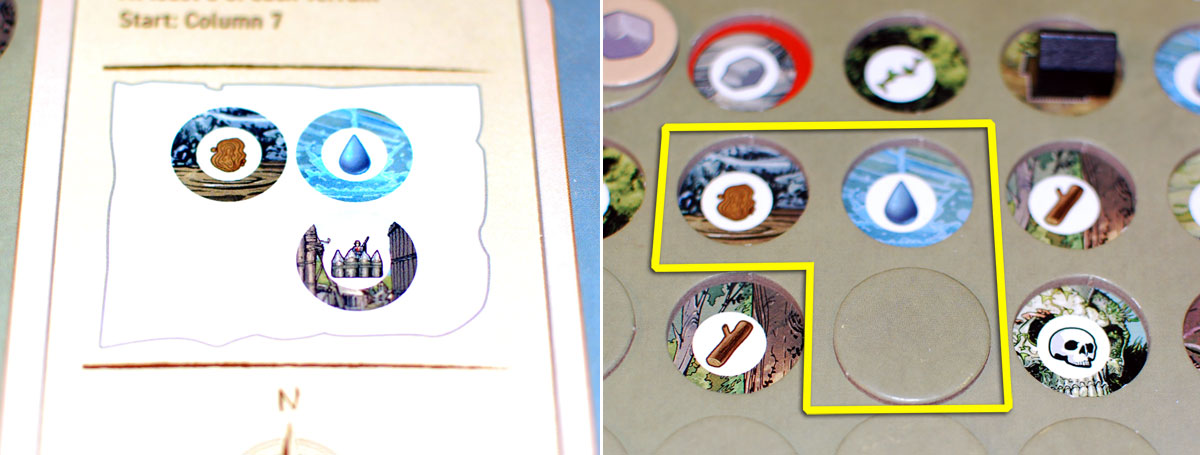
The trick is that it’s not enough just to know where things are. That’s the deduction portion, and it’s important, but you still have to survive. Each day, you’re juggling your ultimate goal—killing three minotaurs, destroying the giant plant hivemind—with all of the other challenges facing you, usually requiring you to seek shelter from weather or other forces of nature. You can ignore challenges up to a point, but failure can cost you resources, water, or even destroy a shelter that you’ve built. Many challenges will fill up your backpack with extra tokens that just take up space, bringing you closer to fatigue. But if you’re too busy chasing after the resources for the challenges, then you might not have enough left to complete the mission.
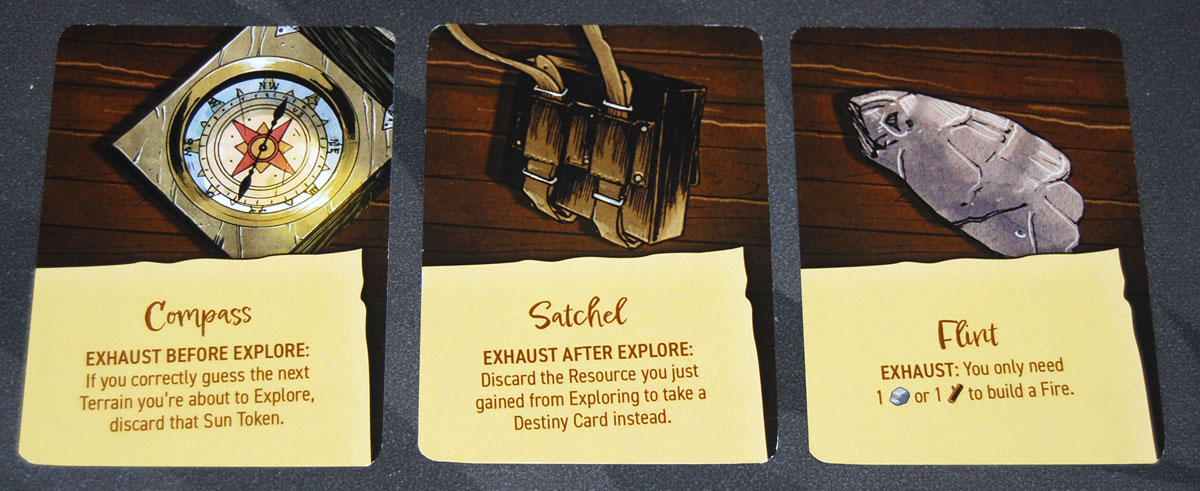
There are other details that I’ve left out here: rewards for exploring an entire row or column of the map, specific character or gear abilities, and more. You’ll need to make the most of it if you’re going to survive!
One interesting restriction is that you only pick up resources on the turn you first explored a location. So every time you need wood, whether for a challenge or to build a shelter or to make a spear, you need to find another wood location on the map. Not only do you have a limited amount of time to address every challenge, but you have limited backpack space, so you can’t simply amass resources and bank them for later. It makes the deduction portion of the game that much more important, so that you can pick up exactly what you need for the next challenge (and, hopefully, make a little progress toward your mission goal too).

Sometimes, though, logic alone simply isn’t enough. There’s always a bit of luck in where you start exploring and which clues you uncover first, as well as the particular order that the challenges or destiny cards arrive in the deck. There are times when things just don’t align, and you have to decide which sacrifices to make. We’ve had times where we figured out exactly where something was … but didn’t have the time to reach it. It’s a dangerous world out there.
The prototype only had enough to play the first two chapters, though it included some components from the following chapters so I could get a glimpse of things to come. As with their game Mind MGMT, Cormier and Lim have created a game where you make your way not only through the story, but also through the game mechanics. There’s a training mission that just shows you the ropes without any threats. Then you meet the minotaurs. Then you have to find your way past carnivorous plants, using fire to keep your troops alive. I like the way that the game adds some new twists and mechanics as you go, and I’m very curious to see what surprises are hidden in later chapters.

If you enjoy deduction games, Corps of Discovery is a cool combination of logic puzzle and survival game. The map board is a great way to represent exploration through an unknown wilderness, and the game forces you and your teammates to make tough decisions about how to spend your precious resources. And, as with Mind MGMT, this game has introduced me to another comic book that I’ll be adding to my reading list.
For more information or to make a pledge, visit the Corps of Discovery Kickstarter page!
Click here to see all our tabletop game reviews.
![]() To subscribe to GeekDad’s tabletop gaming coverage, please copy this link and add it to your RSS reader.
To subscribe to GeekDad’s tabletop gaming coverage, please copy this link and add it to your RSS reader.
Disclosure: GeekDad received a prototype of this game for review purposes.
